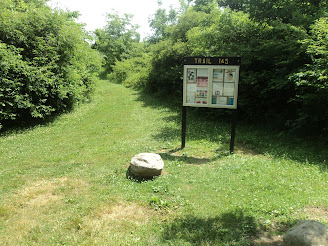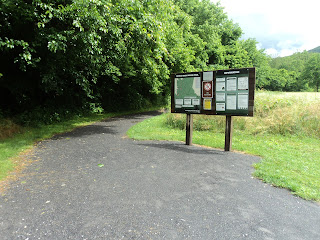Trails: Overlook, Horse Heaven, Cranberry Bogs, and Musket Trails
Hike Location: Droop Mountain Battlefield State Park
Geographic Location: southwest of Marlinton, WV (38.11568, -80.26875)
Length: 2 miles
Difficulty: 3/10 (Easy/Moderate)
Date Hiked: June 2020
Overview: A loop hike around the Civil War battlefield that secured West Virginia for the Union.
Park Information:
https://wvstateparks.com/park/droop-mountain-battlefield-state-park/
Hike Route Map:
https://www.mappedometer.com/?maproute=817026Photo Highlight:
Directions to the trailhead: Droop Mountain Battlefield State Park is located on the west side of US 219 15.3 miles south of Marlinton or 26.5 miles north of Lewisburg. Enter at the main park entrance, then turn right to follow signs for the museum and park office. Park in the parking lot in front of the park office.
The hike: The Battle of Droop Mountain on November 6, 1863 was one of the largest Civil War engagements in West Virginia. Union troops under the command of Brigadier General W.W. Averell and Colonel Thomas Harris were moving south toward the Confederate stronghold of Lewisburg with the ultimate goal of disrupting railroad traffic on the Virginia & Tennessee Railroad further south. Confederate forces under the command of Brigadier Generals John Echols and Albert Jenkins knew that the Union troops would have to come over Droop Mountain in order to reach Lewisburg. Moreover, Droop Mountain's high relief offered the Confederates their best chance to mount a strong defense.
The Confederates were outnumbered more than 3 to 1, but occupying the high ground, significant artillery, and constructed fortifications allowed them to repel Union advances in the morning. By the early afternoon, Averell outflanked the Confederates on their left, and the Confederates fled in a disorganized retreat after a brief but violent battle. All tallied, the Confederates took 275 casualties and lost large quantities of arms and ammunition. Union forces took Lewisburg the next day, and the Battle of Droop Mountain marked the end of organized Confederate resistance and operations in West Virginia.
Due to the efforts of West Virginia House of Delegates' John D. Sutton, a Private in the Union army during the battle, today 287-acre Droop Mountain Battlefield State Park preserves the battle's site. The park was dedicated on July 4, 1928 as West Virginia's first state park. The park offers only a lookout tower, a playground, a small museum, some picnic shelters, and some hiking trails for amenities, so history and nature take center stage here. The hike described here is not the park's longest possible hiking route, but it passes the main historic sites and amenities, thus offering a good overview of the park.
 |
| Trailhead for Overlook Trail |
Start at the north end of the parking area where a sign marks the start of the Overlook Trail; a large interpretive sign describing the white oak tree also stands here. None of this park's trails are marked except at trailheads and intersections, but I found most of the trails easy to follow on my visit. The Overlook Trail curves left and arrives at some trenches dug and occupied by Confederate forces. Some interpretive signs tell you that these trenches are located near the area where the Confederates got outflanked. Imagine what it would be like to hunker down in this trench with an army three times the size of yours advancing on your position.
 |
| Confederate trench |
The trail continues curving left, and at 0.2 miles you reach a northwest-facing overlook platform. Droop Mountain is one of several mountains of similar height in this area, and Round Mountain stands in full view across the valley to the northwest. A small cave called Old Bear Den is also located in this area, and the rugged Big Spring Trail leads downhill to its namesake spring. Head south from the overlook to continue the Overlook Trail.
 |
| View northwest from Droop Mountain |
After passing some rock outcrops bordered by rhododendron, you reach the end of the Overlook Trail at an intersection with the Horse Heaven Trail. Turn right to begin heading south on the Horse Heaven Trail. The Horse Heaven Trail is the most primitive trail used by this hike, and it was somewhat overgrown and hard to follow on my visit. The Horse Heaven Trail parallels the park road, so you can cut through the woods to the left and walk on the park road if trail conditions are too bad.
 |
| Hiking the Cranberry Bogs Trail |
At 0.75 miles, you reach the south end of the Horse Heaven Trail at a combined road and trail intersection. To continue this hike, turn left and cross the road to pick up the Cranberry Bogs Trail. The wide dirt Cranberry Bogs Trail descends gradually on a southeastward course through a dark forest dominated by spruce and hemlock trees. Some mountain laurel in bloom brightened my path on my mid-June visit.
 |
| Cranberry bogs |
Ignore the Old Soldier Trail and continue to follow the Cranberry Bogs Trail as it passes its namesake wetland. The cranberry bogs were actually fairly dry on my visit, and I saw more ferns than cranberries in this "bog." Past the bogs, walk through a complicated trail intersection to reach an old stone trail shelter located beside the park road. Angle left and walk up the paved spur road that leads to the park's famous lookout tower. Steps lead to the top of the wooden lookout tower, which offers fantastic views east across the Greenbrier River valley and into the wooded hills of vast Watoga State Park. Some picnic tables near the lookout tower beckon you to sit, rest, and take in the view.
 |
| View east from lookout tower |
 |
| Lookout tower |
Two trails exit the lookout tower area: the Musket Trail and the Minnie Ball Trail. Both trails lead in the general direction of your car and the park office, but this hike uses the easier, flatter, and better-maintained Musket Trail as its final leg. The Musket Trail descends to cross the main park road only to curve right and intersect the road again at the lowest elevation of this hike. Rather than crossing the road, the trail curves left and climbs moderately to reach the Musket Trail's north end at an intersection with the Cranberry Bogs Trail. Turn right and hike the short final segment of the Cranberry Bogs Trail to return to the park office and complete the hike.











































